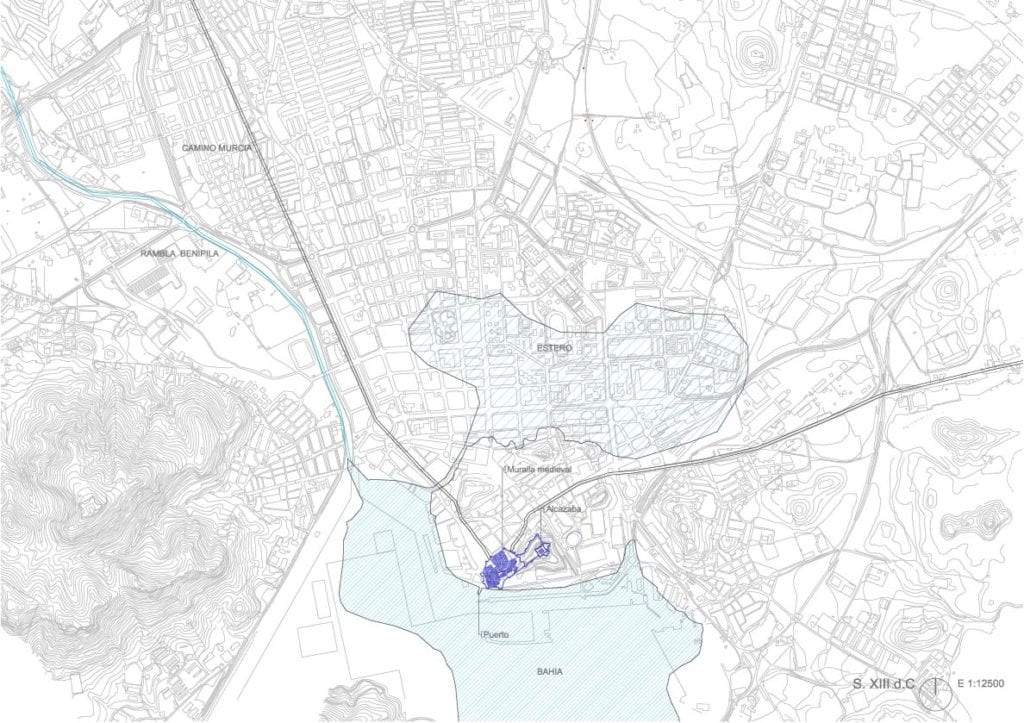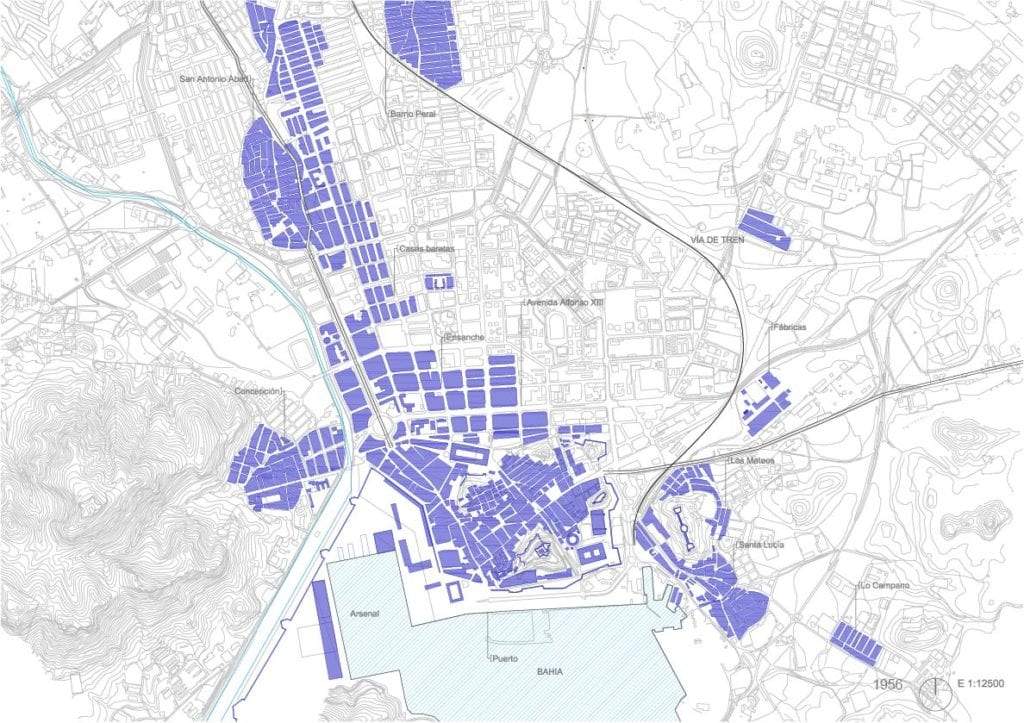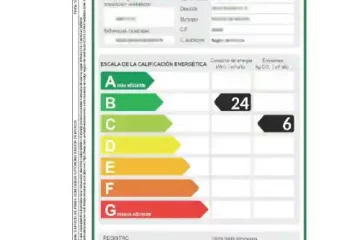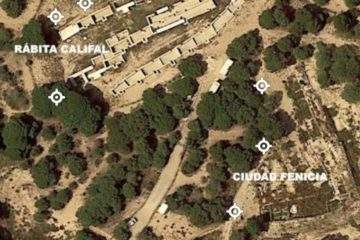Urban development of the city of Cartagena
The city of Cartagena is located in the southeast of Spain. The evolution of its urban fabric has been accompanied by a profound transformation of its environment.
The terrain played a big role in the evolution of the city. It is not surprising, because it was thanks to its peculiar orography that the Carthaginians chose their environment to found Qart Hadasth in 227 B.C. Although some classical sources also mention the city of Mastia around the 6th century BC. This fact induces to think that Asdrúbal did not found the city on an empty lot, but would take advantage of the old settlement of Mastia.
Qart Hadasth, the Punic city.

In 227 B.C. Asdrúbal, son-in-law of General Amílcar Barca and brother-in-law of Aníbal, founded the city of Qart Hadast (new Carthago) in order to ensure control of the mineral deposits in the southeast of the Peninsula. It is likely that it was carried out as a reinforcement and expansion of the old Mastia and not a new one. Although the Punic and Iberian archaeological remains are found below the Roman strata, so little data is available today.
At that time, the terrain on which the city was based and its surroundings were very different from what we find today. Qart Hadasth and later Carthage Nova were on a peninsula made up of five hills: Arx Asdrúbalis, Cronos, Aletes, Hefestos and Asklepios. Currently called: Molinete, Monte Sacro, Monte de San José, Despeñaperros and Monte de la Concepción.
That peninsula was surrounded by the current port, the Mandarache Sea (What remains today is the military dock). And the Estero, an interior lagoon that in ancient times must have been deep enough to allow the transit of ships. This has great similarities with the old port of Cartago, which was divided in two. An outer port for commercial traffic and an inner port, better protected, to protect military ships. In addition to this the outer area of the port was mountainous, which made it difficult for enemy landings.
Carthago Nova, the Roman city.

In the context of the Second Punic War, Roman general Scipio Africanus took Qart Hadasht in 209 BC. C .; renaming it as a Roman possession with the name of Carthago Nova and granting it the treatment of colony with Roman law.
During the empire a slow decline of the city takes place, until in the year 298, the emperor Diocletian divided the Tarraconense in three provinces. Constituting the Roman province Carthaginense, establishing the capital in the city of Cartagena. The city reached its maximum expansion in the 4th century, the urban perimeter established at this time not being surpassed until the 18th century.
During Byzantine rule the city was re-walled and called Carthago Spartaria, capital of the Byzantine province of Spania. Being practically razed after its conquest by Suntila in 622.
Qartayannat al-Halfa, the Islamic city

After the collapse of the Visigothic kingdom in 711 with the battle of Guadalete. The regional nobility agreed with the Muslims to submit in exchange for maintaining their political status and possessions.
This is the case of Teodomiro, which on April 5, 713, Teodomiro agreed with Abd al-Aziz ibn Musa the Pact of Teodomiro, which recognized him in exchange for his submission, the safeguarding of his properties and the government in the territory agreed to the southeast of the peninsula in which Cartagena is included although the population must have decreased so much that it does not appear in the list of cities. The city hardly remained as a fishing village.
Recuperation
Starting in the 10th century, the city experienced a slow recovery favored by the incipient mercantile strength of neighboring Mursiyya. And the military activity of the shipyards during the Emirate. Thanks to which he could have a mosque and a fortified fortress on the current La Concepción hill. In this sense, there are several geographers and travelers who testify to the revitalization of the town, such as Ibn Hawqal, al-Udri or al-Idrisi, who relates:
Cartagena is the obligatory anchorage of the city of Murcia. It is an ancient city that dates back to ancient times. Its port serves as a refuge for large and small ships, it is attractive and full of resources.
Al-Idrisi
There is also documentary and numismatic evidence of a silver mint operating in the Almohad period, 1 and of a Jewish quarter.
During the late Middle Ages, Cartagena will hardly experience growth. Being the main monument that subsists from this time the old cathedral. Although the environment will change enormously. The old Estéro will fill up until it becomes a marsh and will lose communication with the sea. This will allow access to the city to go from being in the old isthmus to ending up crossing a side of the old Stereo, which is renamed Almarjal.
Cartagena in the 16th century

After the reigns of Carlos I and Felipe II, Cartagena's military and defensive role will be greatly enhanced. As the base of the royal galleys and as a military enclave, the walls are reinforced and some coastal fortifications are built, such as the Christmas Fort.
In 1545 a liezo of walls was built in order to protect the El Molinete and Concepción hills. Despite the fact that these walls were never completed, what was built of them is known as "Walls of the Dean". A monumental door remains from this era today, the gate of the villa.
Seeing that in the 16th century the city was unguarded, King Felipe II ordered Duke Vespasian I Gonzaga to fortify it. So in 1570 the first fortification was built with polygonal bastions, the walls of Antonelli. Works of a very poor invoice were carried out, which were ruined very soon after being built.
Cartagena in the 17th century

During the 17th century, various convents were founded, in which orders such as the Dominicans, the Augustinians or the Franciscans settled in the city. While the council's repeated requests to the diocese to have more parishes were systematically rejected. The convents make up a different urban landscape. And the orders that run them channel the cultural, religious and even health life of Cartagena during the entire 17th century.
Cartagena in the 18th century

The great change of the city and its surroundings came with the Bourbon dynasty. During the first half of the 18th century, various fortification works were undertaken in the city. These include the construction of a rampart wall and towers that protected the San Diego suburb in 1721.
Cartagena becomes the capital of the Mediterranean Maritime Department thanks to which the city grows and develops. In addition, King Carlos III orders the fortification of the square. Building between 1771 and 1792 the last walled enclosure that the city had.
In addition, an arsenal and a dock were built on what remained of the Mandarache Sea. The communication of the Rambla de Benipila with this dock was cut to prevent it from getting muddy. So it had to be diverted to the girl Algameca. The swampy terrain of the Almarjal ended at the Rambla de Benipila through the so-called "Anguililla Canal". Which was barely pending. So when the Almarjal lost communication with the port, it became an unhealthy area that caused a multitude of epidemics during the 19th century.
Cartagena in the 19th century

In 1799 there was a transcendent territorial reform in Spain, creating the maritime provinces. Along with those of Alicante, Asturias, Cádiz, Málaga and Santander, the one in Cartagena was created. Segregating it from the province of Murcia and subsisting until the territorial division of Javier de Burgos in 1833
The confiscation process causes the closure of all the existing convents in Cartagena, and with it various modifications in the urban fabric, with the opening of gardens and squares.
At the end of the 19th century, the decision was made to create a widening to relieve the demographic pressure of the city and, in turn, clean up the Almarjal area. To do this, it raised the level of the land in the Almarjal and provided the city with sewage. The economic boom due to the resurgence of the union mines led to the growth of the city, although this growth was made with the back to the port. Well, the ownership by the army of a large part of the land that borders the port and its mountainous character forced to develop the expansion towards the interior.
Cartagena in the 20th century

During the middle of the 20th century, the city took on its current appearance. The energy and fertilizer industry was strengthened, as well as shipbuilding. It was also built zoning by uses. Creating the extension polygon and cheap houses. The consequence was the gradual abandonment of the center in favor of the suburbs. The industrial reconversion, in the last decades of the century, plunged the city into a deep crisis.
The last topographic change in the surroundings of the city is the land reclaimed from the sea, which constitutes the current port and promenade. Which were created in the early twentieth century and the marina at the end of that century.

Cartagena in the XXI century
In the 21st century, the city of Cartagena shows little expansion of the urban fabric, the largest expansion being the expansion of the Santa Lucía neighborhood. Focusing on the recovery of degraded areas of the old town and the recovery of architectural heritage.

In conclusion Cartagena has had to modify its environment and topography in order to develop and grow. Being these transformations the main element to understand the current urban configuration.
Interview conducted in Cadena Ser on 05-06-2020 by Alejandro Moya Bayo in relation to this work. You can access an article on the subject caught in Cadena Ser in the following link.



3 Comments
tantric massage london · at
Im thankful for the blog.
https://www.poojahavanam.com · at
Thanks so much for the article. Really Cool.
https://www.poojahavanam.com/ · at
Major thanks for the blog post. Really looking forward to read more. Great.